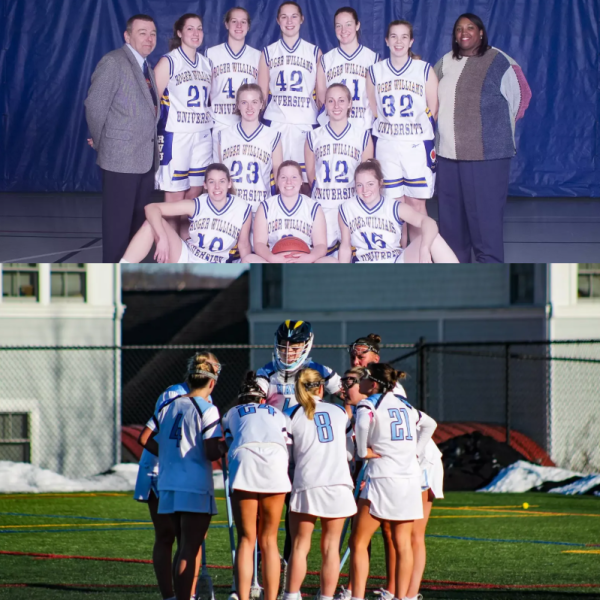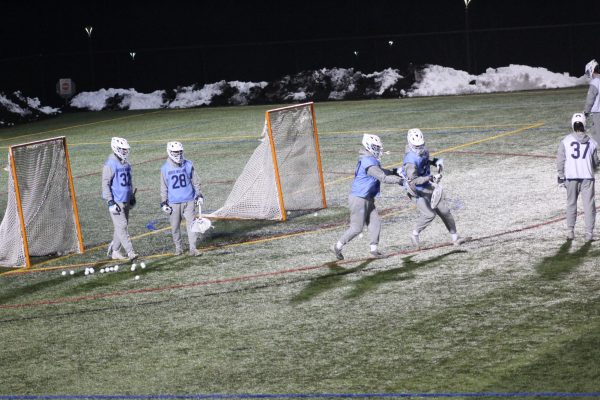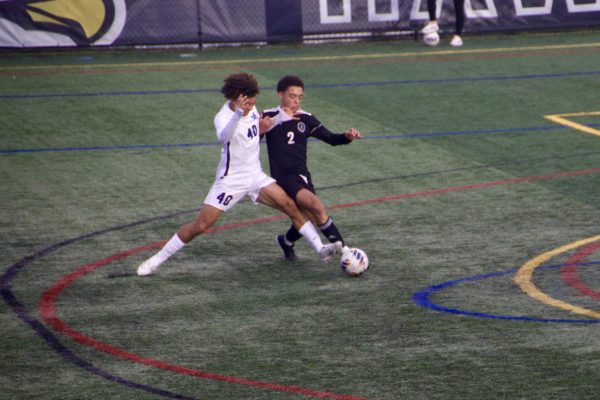The Fall of Roger Williams College Football
School years have gone by and students have graduated, but the Roger Williams College football team‘s existence, and ending, has continued to be a campus myth. Almost any trace of its presence has been lost both on campus and in archives.
The conference that the team played in has an online timeline dating back to 1965 that shows details of teams that joined and left over the 51-year history of the New England Football Conference — but not Roger Williams. Even the mural by the Athletics Department that displayed two of the school’s football players has been replaced by a blank white wall.
The most popular belief among students is that the team burned down a building. The team’s possible motives vary from a rivalry between them and Greek life on campus to retaliating to the news that the football team would no longer be funded.
“What I heard freshman year was the football team burned Cedar — someone told me it was Cedar,” junior Joey Gulino said.
“That’s what I heard,” another student said.
From a 1987 article in “The Messenger,” the Roger Williams College newspaper from 1982-1993, Student Senate played a role in some controversy surrounding the team. Football, officially a club sport, was granted money from Student Senate, but was found at the wrong end of a vote that year. The newspaper issue, released on April 21 of that year, stated that the team requested, but was denied, $28,000 for a budget the following fall season. Adjusting for inflation, the sum that the team asked for in April 1987 would be equal to $62,247.45 in April of this year — 31 years later.
A referendum was taken, according to “The Messenger” writer Nancy Wilkins, and it was found that students preferred to keep the funding for football. Even after obtaining that information, Student Senate opted not to use it and voted against funding the team. A university Budget Committee meeting was then held and influenced the Student Senate to change their decision and continue the funding of the team.
The team played again, as expected, but was ended following their 1988 season.
Aside from the off-field issues involving their budget, the Roger Williams College Seahawks faced problems on the field. According to a 1985 issue of “The Messenger,” the football team gave up the most points (2707) and scored the second fewest (1324) through seven games that year.
“We started to get mauled. So, that led to some issues. Year three was not a pretty year — I don’t think they won a game,” said former Athletic Director Dave Kemmy.
The team went 0-8 that year.
According to Kemmy, the main problem the team had was the short list of people who wanted to play football for Roger Williams. The official 1983 roster had a list of 42 names. After just one year and six graduated seniors, the 1984 roster had only 28.
According to the 1988 yearbook, the team had a slight jump in numbers and gathered a squad of 34 players. Kemmy said for that year’s team, about 20 were active team members. The norm at a collegiate level is to have 11 exclusively offensive players and 11 defensive ones with a few specialty players, like a kicker and punter. With a small squad, former head coach Joe Almeida Jr. had to place his players in different positions on both sides of the ball throughout games.
“It was a catastrophe,” said Kemmy. “The coach quit, the players basically quit and the main reason why they discontinued it was because there were 20 kids. They certainly could not have a football team. With less than 50, they would be pushing it.”
On top of all the issues the team faced with funding and on-field performance, they failed to make their mark on campus. The team played their games on the same field that the current softball and baseball teams play on. Even though the games were close by, some students who attended the college in the mid-80s had no idea that a football team ever existed.
“I don’t think there was a football team when we were there,” said Lori Raber, a student from 1986-1990.
While it may be hard to believe a football team would exist and then be forgotten about, the years that Roger Williams had a football team were certainly a forgettable period.
The other rumor that typically accompanies the fire is that the team cannot be reinstated for another century.
“I heard there was a clause that we’re not allowed to have a football team for a certain amount of years — 100 years or something,” said Gulino.
Kemmy stated that while he was the athletic director, the idea of resurrecting the team was actually briefly considered. But in the end, it came down to how much it would cost the school, not a century-long ban. The program would need to spend money on a new locker room large enough for the team, a coaching staff, equipment, uniforms and most importantly, insurance.
“Right now,” Kemmy said, “you’re talking an operating budget of $300-$350 thousand a year, which is more than the rest of our sports combined.”
For the coming academic year, Student Senate has $1,056,000.00 to distribute to clubs and organizations across campus, according to Treasurer Jordan J. Phelan. The amount of money needed to annually fund a club football comeback would take 28.4-33.1 percent of Student Senate’s current budget.
Unless the organization decides to underfund all the other clubs offered on campus, football is staying far away from Roger Williams University.





Jason A Curtis • Jul 29, 2021 at 10:39 am
I was a member of the last football team at RWC. I was also a member of the Baseball and Basketball team that won the Costal Conference Championship in 87. Most of what i read about the football team was true, we were small in number and we did loose every game. The team had on it 3 division one players (URI, UCONN and UMASS) and your right we played both ways once we saw that talent wise we were not going to keep pace with teams that outnumbered us 2 to 1.
We would be good up until half time and then we would just get tired out, I read that we quit and that is not true what we did was worked our tails off and played hard to the end. We would just run out of gas and just could not keep up with teams that doubled our numbers.
We lost allot of games by one 10 or less which also says that we could score points. We were a club team and we were everyone’s home coming game (NOT COOL). We scared allot of teams and sent them to the locker room at half thinking.
The team had two bright spots one of those was that at some point during the game all three LBs were D1 athletes. The other was that we LED the conference in passing yard by 300 plus yards.
Thanks for listening, reach out if you want to know more.
Jason L Curtis Class of 88.
Ed Martinez#33 • May 11, 2024 at 11:36 am
Hi Jason not sure if you played there when I was there 84-86 got a season ending ACL torn and that was the end of it. Coach Almeida used his own money to keep that program going. Coach Mo was the master mind and we executed until we got tired. We never burnt down any building. We never started any issues so all that is false at least not while I was there. I left in 86 back home and continued by studies in NJ. We had a talented team with lots of heart. Wish the athletic director at the time can’t remember his name (red headed gentleman) would have raised us to D3. Every team we played back then still exists in either D2 and D3 and one team at least is D1. Someone needed to put money into it. As to the student council, I was a senator at the time and I can tell you the issue came down to nerdy leader of the council that had an absolute angst against the team. The man found every excuse in the book to screw over the football team and used pressure tactics to get the votes he needed. Not with me obviously but with others.
Bill mccagney • Nov 5, 2024 at 3:36 pm
Hi Eddie I remember you. My name is Bill mccagney and I was an assistant coach in 1983 and 1984. As you might recall we had a winning record in 1983 with five wins and four losses Under head coach Joe Almeda. He was assisted by myself most entry and Dennis perry. In 1984 we were Four Winds and six losses. So we did have some success. 1984 was my last year at Roger Williams and I understand the team went downhill after that. But we had some great kids some great players and some great memories we should have a reunion someday. Thank you Bill mccagney